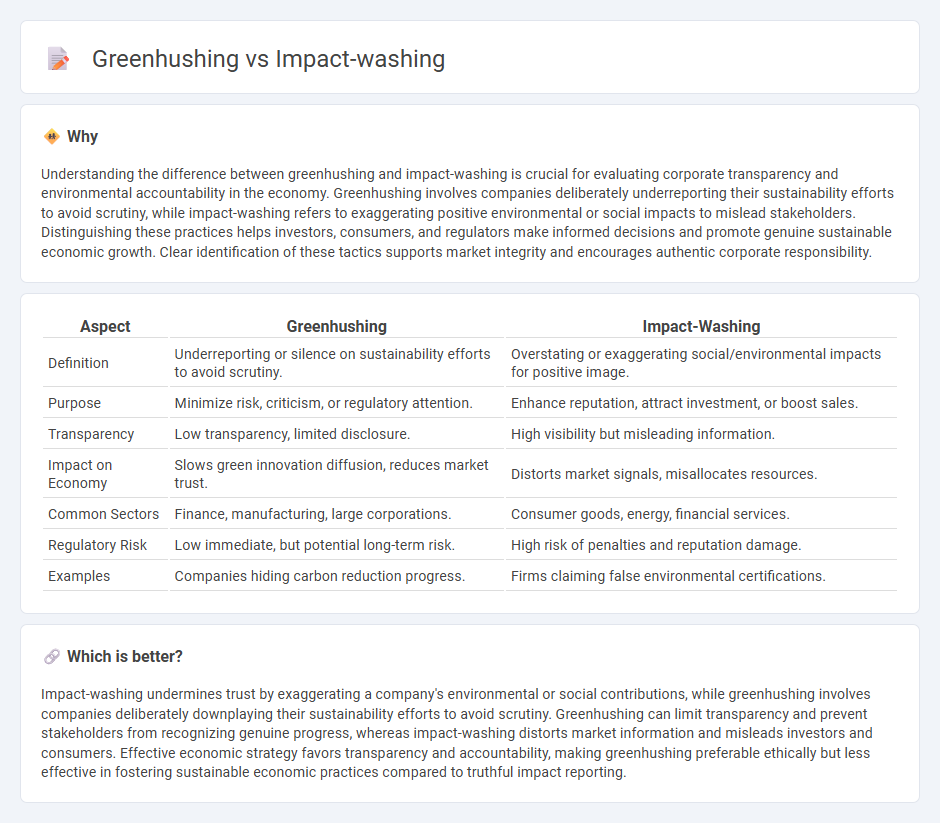
Greenhushing occurs when companies deliberately underreport or hide their environmental initiatives to avoid scrutiny, while impact-washing involves exaggerating positive social or environmental impacts to enhance corporate image. Both practices distort transparent communication, affecting investors, consumers, and policymakers seeking genuine sustainability commitments. Explore deeper insights into how these tactics influence corporate accountability and market dynamics.
Why it is important
Understanding the difference between greenhushing and impact-washing is crucial for evaluating corporate transparency and environmental accountability in the economy. Greenhushing involves companies deliberately underreporting their sustainability efforts to avoid scrutiny, while impact-washing refers to exaggerating positive environmental or social impacts to mislead stakeholders. Distinguishing these practices helps investors, consumers, and regulators make informed decisions and promote genuine sustainable economic growth. Clear identification of these tactics supports market integrity and encourages authentic corporate responsibility.
Comparison Table
| Aspect | Greenhushing | Impact-Washing |
|---|---|---|
| Definition | Underreporting or silence on sustainability efforts to avoid scrutiny. | Overstating or exaggerating social/environmental impacts for positive image. |
| Purpose | Minimize risk, criticism, or regulatory attention. | Enhance reputation, attract investment, or boost sales. |
| Transparency | Low transparency, limited disclosure. | High visibility but misleading information. |
| Impact on Economy | Slows green innovation diffusion, reduces market trust. | Distorts market signals, misallocates resources. |
| Common Sectors | Finance, manufacturing, large corporations. | Consumer goods, energy, financial services. |
| Regulatory Risk | Low immediate, but potential long-term risk. | High risk of penalties and reputation damage. |
| Examples | Companies hiding carbon reduction progress. | Firms claiming false environmental certifications. |
Which is better?
Impact-washing undermines trust by exaggerating a company's environmental or social contributions, while greenhushing involves companies deliberately downplaying their sustainability efforts to avoid scrutiny. Greenhushing can limit transparency and prevent stakeholders from recognizing genuine progress, whereas impact-washing distorts market information and misleads investors and consumers. Effective economic strategy favors transparency and accountability, making greenhushing preferable ethically but less effective in fostering sustainable economic practices compared to truthful impact reporting.
Connection
Greenhushing and impact-washing are connected through their roles in corporate environmental communication, where companies either underreport sustainability efforts or exaggerate social and environmental impacts to influence public perception. Both practices undermine transparency by obscuring the true extent of a company's commitment to environmental responsibilities, complicating efforts to hold corporations accountable for their sustainability claims. This connection reveals challenges in regulatory frameworks and the need for stricter verification standards to ensure accurate reporting of environmental and social impacts.
Key Terms
Corporate Social Responsibility (CSR)
Impact-washing occurs when corporations exaggerate their social and environmental achievements to enhance their public image without substantial actions, while greenhushing refers to companies deliberately withholding information about their CSR efforts to avoid scrutiny or backlash. Both practices undermine genuine Corporate Social Responsibility by distorting transparency and accountability, leading to decreased stakeholder trust. Explore how organizations can foster authentic CSR by balancing transparency and strategic communication.
Transparency
Impact-washing involves overstating a company's positive environmental or social contributions to appear more responsible, while greenhushing refers to deliberately underreporting or hiding such efforts to avoid scrutiny or criticism. Both practices undermine transparency, eroding stakeholder trust and hindering meaningful sustainability progress. Explore how fostering honest communication can enhance corporate accountability and environmental integrity.
Stakeholder Communication
Impact-washing refers to companies exaggerating their environmental or social efforts to appear more responsible, while greenhushing occurs when organizations underreport or hide their sustainability initiatives to avoid scrutiny or criticism. Effective stakeholder communication demands transparency and balanced messaging to build trust and credibility in sustainability claims. Explore further to understand strategies for optimizing stakeholder engagement in environmental and social responsibility.
Source and External Links
Unmasking Impact Washing: Keys to genuine impact investing - Impact washing is a deceptive practice where companies claim social and environmental improvements without truly committing to substantive changes, threatening the authenticity of impact investing and misdirecting financial resources from genuine projects.
What is Impact Washing? Meaning and how to avoid it | SBD - Impact washing refers to intentional disinformation by organizations or investors exaggerating or falsifying positive social and environmental impacts to appeal to ethical concerns, making it harder to achieve actual long-term beneficial changes for people and the planet.
Impact washing: what is it and how to spot it - ISO - Impact washing is defined as marketing claims about a product or investment triggering real economic change without evidence, such as claiming carbon emissions are reduced without proof, misleading consumers about true environmental benefits.
 dowidth.com
dowidth.com